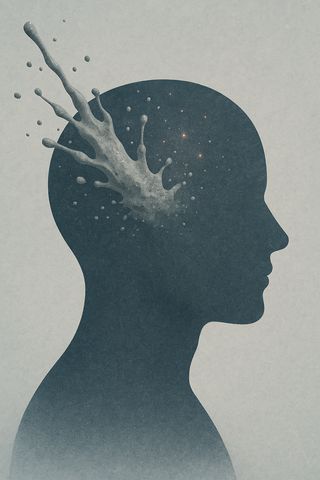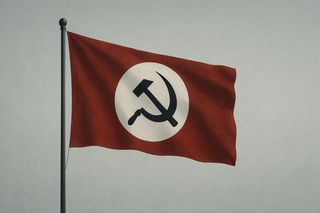Consider, for a moment, a flag: a stark red banner, the color of international revolution. In the center, a white circle reminiscent of the iconography of European fascism. And inside that circle, a black hammer and sickle, the symbol of Soviet Communism.
From a conventional political science perspective, this flag is complete nonsense. It's a visual paradox, forcibly combining the fiercely irreconcilable symbols of the 20th century's most violently opposed ideologies. It represents National Bolshevism, a movement attempting to be both nationalist—a creed of the far-right obsessed with ethnic and cultural purity—and Bolshevik—a creed of the far-left built on class-based international revolution.
When we try to analyze such an ideology as a coherent philosophy, we fail. It falls apart under the slightest logical scrutiny. And yet, this ideology has re-emerged multiple times over the last century.
This essay will argue that the key to understanding such movements is to view ideologies not as pure philosophies seeking truth, but as competitive systems of belief that survive and thrive based on their ability to resonate with and organize a receptive population. From this perspective, the emergence of National Bolshevism isn't a historical accident; it's a predictable outcome of specific environmental conditions.
Think of an ideology less as an abstract 'idea' and more like wet cement splashed across people's brains, books, and network bandwidth. Once it sets, it's as real—and as hard to chip out—as any sidewalk.
1. The Petri Dish: Chaos and the Receptive Environment #

Radical, hybrid ideologies don't emerge in stable, prosperous societies. They take root and flourish in what can be called a "receptive environment"—a social landscape where the dominant belief systems and institutions that once gave people a sense of order and identity have collapsed. This collapse creates a vacuum of meaning, leaving a population psychologically vulnerable and open to radical new ideas that promise to restore order and purpose.
In those soft-clay moments—when institutions crumble and the ground feels like mud—any sharp new story can stamp its outline deep and fast.
1.1 Case Study: Post-WWI Germany #
The Weimar Republic was born from defeat and humiliation. The old imperial system that had defined German identity was gone, replaced by a fragile democracy that many associated with the humiliating Treaty of Versailles. This environment was exceptionally receptive to new political experiments.
-
Institutional and Mythological Collapse: The monarchy was abolished and the narrative of the invincible German army was shattered, leading to the "stab-in-the-back" myth. This created a vacuum of authority and a crisis of national identity. In this chaos, paramilitary groups like the Freikorps—composed of disillusioned veterans—became influential actors who were violently anti-communist but also despised the liberal republic.
-
The Appeal to Conservative Revolutionaries: Thinkers like Ernst Niekisch and Ernst Jünger articulated a "third way" that rejected both Western capitalism and Soviet internationalism. They envisioned a uniquely German path that would fuse the discipline and nationalism of the old Prussian right with the revolutionary, anti-bourgeois energy of the socialist left. For them, National Bolshevism was a potential alliance with a nationalist-leaning Russia to overthrow the liberal Western order imposed at Versailles.
-
Economic Despair: The burden of war reparations and the hyperinflation of the early 1920s destroyed the economic security of the middle class, fostering deep resentment towards both international financiers and the perceived weakness of the democratic government.
This created a perfect opening for an ideology that could appeal to soldiers who hated the republic but also felt betrayed by the industrialists who had profited from the war.
1.2 Case Study: 1990s Russia #
The fall of the Soviet Union in 1991 created one of the most sudden and complete societal collapses in modern history, making it an almost perfectly receptive environment for radical ideas.
-
Ideological Vacuum: For 70 years, Marxism-Leninism had been an all-encompassing belief system. Its sudden collapse left an immense ideological void, which a weak and discredited democratic movement could not fill.
-
Economic Shock and Humiliation: The transition to capitalism was a brutal "shock therapy" that led to hyperinflation, mass unemployment, and the rise of a new class of oligarchs who plundered state assets. This created widespread animosity towards both capitalism and the new "democratic" leaders seen as its agents.
-
Loss of Superpower Status: Russia transformed from a global superpower to a state perceived as a bankrupt client of the West. This profound national humiliation created a powerful yearning for a restored sense of destiny and strength. In this environment, figures like Eduard Limonov (a provocative writer) and Aleksandr Dugin (a traditionalist philosopher) formed the National Bolshevik Party in 1993. Their movement was a form of political performance art and radical action, attracting punk rockers, alienated intellectuals, and veterans of post-Soviet conflicts who were disgusted with both the communist past and the capitalist present.
This environment of dual humiliation—the failure of communism and the predatory nature of capitalism—created the ideal niche for an ideology that promised to restore both national pride and social justice.
2. Ideological Frankensteins: The Strategy of Hybridization #
National Bolshevism wasn't an entirely new invention. It was a political Frankenstein, assembled by borrowing and combining the most powerful, emotionally resonant components from the most successful ideologies of its time. Its core purpose is to fuse the revolutionary energy of the left with the identity-based cohesion of the right.
From the Nationalist Playbook: #
-
Primacy of the Nation: It borrows the core belief that the nation-state, defined by a unique cultural and spiritual identity (the German Volk or the Russian Narod), is the ultimate unit of human importance, overriding all other allegiances like class or creed.
-
Militarism and the "Heroic Ideal": It adopts the aesthetics of military strength, discipline, and parades, celebrating the soldier as the ideal citizen who finds meaning in sacrifice for the collective. Society is framed as being in a state of constant struggle.
-
A Clear External Enemy: It defines the nation in opposition to a corrupting "other." This enemy is consistently identified as the decadent, materialistic, and rootless liberal West, embodied by international finance and parliamentary democracy.
From the Bolshevik Playbook: #
-
Revolutionary Upheaval: It co-opts the Leninist call for a total and violent overthrow of the existing order. It is not an ideology of reform, but of razing the old world to build a new one from the ashes.
-
Targeted Anti-Capitalism: It channels the potent Marxist critique of economic exploitation, but focuses the anger not on a generic bourgeoisie, but specifically on international bankers and financiers, often blending this with nationalist and antisemitic tropes.
-
Nationalized Social Justice: It steals the promise of social justice—state control of industry, wealth redistribution, a social safety net—but strips it of its internationalist character. The goal is not to liberate the world's proletariat, but to create a self-sufficient, state-managed economy that serves the material needs of its own nation exclusively.
The goal of this hybrid system isn't logical purity; it's competitive advantage.
This fusion is perfectly encapsulated in its symbolism: the flag of the Russian National Bolshevik Party placed the communist hammer and sickle inside the white circle of a Nazi-style battle flag, set against a stark red background. It is a visual declaration of its hybrid nature, designed for maximum emotional impact and recognition.
Once the prototype starts circulating, it mutates in small ways—slogans get tweaked, symbols remixed—and the versions that hook the most converts crowd out the rest. Over time, only the fittest mash-ups survive.
3. Resonance Over Reason: Why It Feels More True Than It Is #
This hybrid ideology was never designed for mass appeal or philosophical debate. It was engineered to deeply resonate with a very specific psychological profile: the individual who feels simultaneously humiliated as a member of a defeated nation and exploited as a member of a powerless economic class.
-
Validating the Individual's Worldview: For this person, National Bolshevism is a profound validation. It offers a single, unifying explanation for their suffering. The same enemy—the amorphous "globalist liberal order"—is blamed for both the nation's geopolitical weakness and the individual's economic misery. The ideology provides an immense sense of relief by confirming the individual's deepest suspicions: their problems are not their fault, and their seemingly separate grievances are actually two fronts in the same epic war. It streamlines a complex world into a simple, heroic struggle.
-
The Power of Internal Narrative: For someone who adopts this worldview, the logical inconsistency of the ideology is irrelevant. What matters is its internal narrative coherence. The story it tells about the world is emotionally satisfying and provides a powerful sense of identity and purpose. It replaces the chaos of a collapsed society with the ironclad certainty of a Manichean struggle between good (the pure, heroic nation) and evil (the corrupt, internationalist elite). This feeling of belonging and righteous anger is far more psychologically compelling than any abstract philosophical argument.
The belief system works because it feels true, not because it is true in any objective sense.
In other words, what political scientists now call the post-truth era is simply this phenomenon writ large: when the emotional coherence of a story outranks its factual coherence, facts become negotiable commodities.
4. Why It Works: A Systems Perspective #
If we step back from the specific content of National Bolshevism, we can see a universal set of mechanics at play, almost like watching a lifeform in a nature documentary. Ideologies, like any living system, compete for resources—in this case, the attention and devotion of human beings. The ones that succeed aren't always the most "correct," but the most effective at surviving and spreading.
This systems perspective reveals a clear pattern:
-
Find a Vulnerable Environment: A belief system first needs fertile ground. In societies where old certainties have crumbled, people are desperately searching for a new story to make sense of the world. This chaos creates the perfect opening for a fast-spreading story—one that can take root, stabilize, and start copying itself faster than rival narratives.
-
Build a Better Competitor: Instead of inventing something entirely new, it's more effective to take the strongest parts of existing, successful ideas and combine them. By borrowing the tribal loyalty of nationalism and the revolutionary anger of communism, National Bolshevism built a hybrid that was more potent for its target audience than either of its parents.
-
Target a Specific Niche: The most successful systems don't try to appeal to everyone. They find a specific group with a specific set of grievances and offer a perfect, tailored solution. National Bolshevism thrived by speaking directly to those who felt crushed by both national humiliation and economic injustice.
-
Fuse with Identity: Once a person adopts the belief system, it begins to rewire their identity. It becomes more than a set of opinions; it becomes who they are. It also quietly redirects their time, energy, and even money toward keeping the movement alive—funding rallies, resharing content, policing dissent. Over time, the story doesn't just live inside its believers; it starts rearranging the outside world—clubhouse rules, city murals, even the weekend calendar—so everything around it keeps the rhythm. At this point, any attack on the ideology is perceived as a personal attack on themselves, and they will defend it with the same ferocity they would use to defend their own life. This is how a belief system "locks in" its host and ensures its own survival.
These mechanics explain why such ideologies can be so powerful and so difficult to dislodge, regardless of their connection to facts or logic.

5. Conclusion: A Lesson for a Modern, Unstable World #
The story of National Bolshevism is more than just a historical curiosity. It is a critical lesson for our time, as we live in an era of unprecedented informational chaos—a globally "receptive environment" where traditional sources of stability are weakening and the speed of information flow is dizzying.
The Rise of New Hybrids: #
We should expect to see the emergence of more strange, seemingly contradictory ideologies that fuse powerful elements from different traditions. Below are four hybrids that have already begun to surface—and the social niches they exploit:
Eco-Nationalism (“Eco-Fascism”) #
A green veneer wrapped around ethnonationalist politics. Advocates borrow the urgency of climate activism ("the planet is dying") but redirect the blame toward immigrants or ethnic "outsiders" who supposedly strain a nation's finite ecological carrying capacity.
Concrete echo: The 2019 Christchurch and El Paso manifestos both framed mass violence as environmental self-defence on behalf of a threatened homeland.
Spiritual Capitalism #
New-Age wellness meets hustle-culture individualism. It preaches inner enlightenment through premium products, retreats, and crypto investments—selling transcendence as a subscription service.
Concrete echo: Influencer brands like Goop merge esoteric healing claims with upscale consumerism, while "manifestation coaches" pitch spirituality as a pathway to six-figure passive income.
Techno-Authoritarianism #
Promises of friction-free efficiency and high-tech progress fused with expansive state (or corporate) surveillance and control.
Concrete echo: China's Social-Credit pilot projects and the rapid export of AI-driven policing tools illustrate how Marxist-Leninist symbolism can coexist with hyper-capitalist digital governance.
Techno-Monarchism (“Exit & Throne”) #
A Silicon-Valley-flavored push to scrap liberal democracy in favor of CEO-style sovereigns or "patchwork" city-states. It marries libertarian startup culture to reactionary monarchy—an unsettling twist that markets absolute power as a software update.
Concrete echo: Curtis Yarvin's "Cathedral" essays, VC podcasts pitching "crypto-cities" as governance platforms, and invite-only conferences debating a corporate king's "reboot" of the republic.
A New Toolkit for Analysis: #
The lesson from National Bolshevism is that we should waste less time pointing out the logical flaws of these emerging belief systems. That is not the battle being fought. To truly understand them, we must ask the more potent questions this analysis provides:
- What chaotic social environment is this ideology colonizing?
- What powerful ideas and symbols is it borrowing?
- And most importantly, whose specific, unmet grievances does it so perfectly validate?
Answering those questions is the essential first step in navigating the turbulent ideological landscape of the 21st century.
Of course, even the fiercest narrative can crack—when it runs out of fresh converts, hits a wall of cold facts, or meets a stronger counter-story. A belief lives only as long as it keeps the human energy flowing.
Further Reading & Theoretical Framework #
For those interested in deeper dive into the principles that power systems-level analysis in Section 4, here are a few links:
- Read more on the "subjective perspective" that the ideology validates.
- Read more on the fusion of belief and identity.
- And if you are looking for an epistemic perspective, check out the philosophy behind the reasoning in this post.



